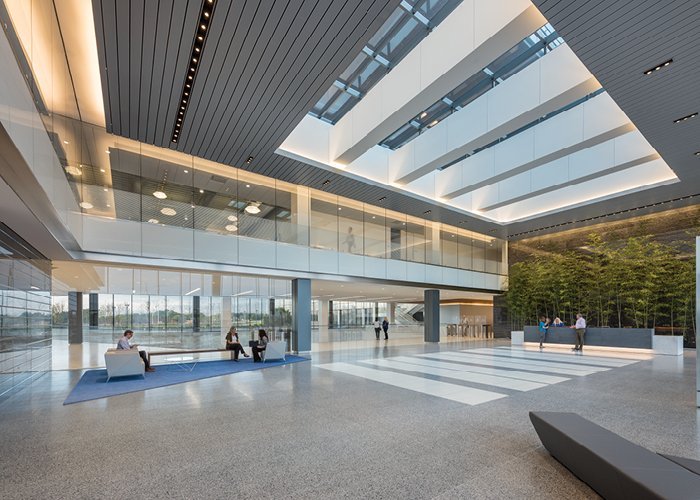This piece was originally published in the March/April 2019 issue of electroindustry.

The new Zurich North America headquarters in Schaumburg, Ill., was designed to be a creative and collaborative work environment as well as set a Standard for future Zurich offices. A new integrated lighting and shading control solution automatically monitors and adjusts daylight and electric light to help maximize the comfort and productivity of its employees throughout the corporate campus.
Challenge
As part of the planning process, Zurich management surveyed employees, who expressed a significant preference for an environment filled with natural light. The Chicago-based architecture firm Goettsch Partners designed the curtain wall system in the predominantly glass structure to deliver the desired productive, bright, open atmosphere. The architects also knew that unchecked daylight could create glare and heat gain, mitigating the advantages of the sunlight.
Solution
Goettsch Partners chose an integrated lighting control and shade solution to automatically monitor and adjust the total light environment. Solar-adaptive shading software ensures that the low-voltage motorized shades quietly and unobtrusively respond to the changing position of the sun, maximizing natural daylight, improving occupant comfort, preserving views, and eliminating disruptive glare.
The system incorporates a broad range of additional control strategies, including daylighting, occupancy sensing, simple integration with time clocks and the HVAC system, and personal control to accommodate personal light preferences. To achieve Zurich’s goal of maximizing the view through closed shades, Goettsch selected a dark solar-screen fabric with a low openness factor to reduce diffuse light while preserving the view to the outside.
The low-voltage shading and light management solution simplifies design, installation, setup, and system integration, says Randall Chapple, Associate Principal at Goettsch Partners.
“Because the shades and the controls feature low- voltage wiring, installation was easier and more cost-effective than other options,” he said. “Our ability to minimize wiring material cost, as well as reduce time and labor costs, was a major consideration in our choice. These were critical to meeting project timelines.”
Results
Zurich’s new automated shading solutions help regulate building temperature, lower energy use, reduce heat gain, reduce glare, and provide a consistent look from outside and inside the building.
The comfortable, flexible environment contributes to a campus that enhances communication and collaboration. The roller shades with Hyperion software were a contributing factor in achieving credits toward LEED Platinum Core and Shell certification in the following categories:
- EAp2: Minimum Energy Performance
- EAc1: Optimize Energy Performance (21 points achieved)
- IEQc8.1: Daylight and Views, Daylight 75% of Spaces (1 point achieved)